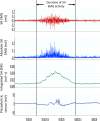Mandibular advancement impairs swallowing ability more than head extension but less than mouth opening in the supine position
- PMID: 31882971
- PMCID: PMC6934452
- DOI: 10.1038/s41598-019-56843-8
Mandibular advancement impairs swallowing ability more than head extension but less than mouth opening in the supine position
Abstract
Mandibular advancement in the supine position may influence swallowing during dental treatment under intravenous sedation. This study investigated the influence of mandibular advancement in the supine position on swallowing ability, compared with head extension and mouth opening. The water swallowing test was performed in 13 healthy, awake, supine, adult subjects under four head and mandibular positions. An electromyogram of the suprahyoid muscles was recorded; the duration and peak amplitude were examined. A greater volume of water remained in the mouth during mouth opening and mandibular advancement relative to the neutral position; the volume in the mandibular advancement position was larger and smaller than that in the head extension position and during mouth opening, respectively. The duration of the electromyogram in the head extension position was longer than that in the mandibular advancement position, without differences in the amplitude. Thus, swallowing ability in the supine position was more impaired with mandibular advancement, relative to neutral and head extension positions, but less than that observed with mouth opening. Although unconfirmed by electromyogram, our findings suggest that head extension might improve airway patency by reducing the impairment of swallowing ability compared with mandibular advancement.
Conflict of interest statement
The authors declare no competing interests.
Figures



Similar articles
-
Both head extension and mouth opening impair the ability to swallow in the supine position.J Oral Rehabil. 2014 Aug;41(8):588-94. doi: 10.1111/joor.12175. Epub 2014 Apr 17. J Oral Rehabil. 2014. PMID: 24738927
-
Effect of head and jaw position on respiratory-related motion of the genioglossus.J Appl Physiol (1985). 2016 Apr 1;120(7):758-65. doi: 10.1152/japplphysiol.00382.2015. Epub 2016 Jan 21. J Appl Physiol (1985). 2016. PMID: 26796752
-
The mandible advancement may alter the coordination between breathing and the non-nutritive swallowing reflex.J Oral Rehabil. 2010 May 1;37(5):336-45. doi: 10.1111/j.1365-2842.2010.02067.x. Epub 2010 Mar 10. J Oral Rehabil. 2010. PMID: 20337868
-
Changes in airway and hyoid position in response to mandibular protrusion in subjects with obstructive sleep apnoea (OSA).Eur J Orthod. 1999 Aug;21(4):363-76. doi: 10.1093/ejo/21.4.363. Eur J Orthod. 1999. PMID: 10502899 Review.
-
Head posture and hyo-mandibular function in man. A synchronized electromyographic and videofluorographic study of the open-close-clench cycle.Am J Orthod Dentofacial Orthop. 1988 Nov;94(5):393-404. doi: 10.1016/0889-5406(88)90128-x. Am J Orthod Dentofacial Orthop. 1988. PMID: 3055938 Review.
Cited by
-
Striving for humane deaths for laboratory mice: hypobaric hypoxia provides a potential alternative to carbon dioxide exposure.Proc Biol Sci. 2023 Apr 26;290(1997):20222446. doi: 10.1098/rspb.2022.2446. Epub 2023 Apr 26. Proc Biol Sci. 2023. PMID: 37122253 Free PMC article.
-
Effect of mandibular advancement device on plasticity in corticomotor control of tongue and jaw muscles.J Clin Sleep Med. 2021 Sep 1;17(9):1805-1813. doi: 10.5664/jcsm.9284. J Clin Sleep Med. 2021. PMID: 33904391 Free PMC article. Clinical Trial.
-
Comparison of the innovative endoscopic oropharyngeal airway and the conventional mouthpiece in elderly outpatients undergoing esophagogastroduodenoscopy under sedation: a prospective and randomized study.BMC Gastroenterol. 2022 Jan 6;22(1):8. doi: 10.1186/s12876-021-02089-6. BMC Gastroenterol. 2022. PMID: 34991464 Free PMC article. Clinical Trial.
References
MeSH terms
LinkOut - more resources
Full Text Sources

